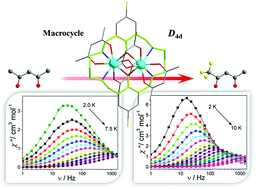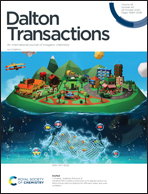Macrocycle supported dimetallic lanthanide complexes with slow magnetic relaxation in Dy2 analogues†
Abstract
Six dimetallic lanthanide complexes, [Ln2(L′)(acac)4] (1Dy–3Gd) (Ln = Dy (1Dy), Tb (2Tb) and Gd (3Gd)) and [Ln2(L′)(tfac)4] (4Dy–6Gd) (Ln = Dy (4Dy), Tb (5Tb) and Gd (6Gd)) (H2L′ = 1,9-dichloro-3,7,11,15-tetraaza-1,9(1,3)-dibenzenacyclohexadecaphane-2,10-diene-1,9-diol), have been synthesized by the reaction of lanthanide nitrates with the HL ligand in the presence of acetylacetonate (acac) (or trifluoroacetylacetonate (tfac) and triethylamine (HL = 4-chloro-2,6-bis(-((3-((3-(dimethylamino)propyl)amino)propyl)imino)methyl)phenol). Ln-Assisted modification of the Schiff base HL occurred and led to the formation of a new macrocyclic ligand (H2L′). X-ray crystallographic analysis revealed that the LnIII ions of complexes 1Dy–6Gd are all eight-coordinated in a square antiprismatic geometry with D4d local symmetry. Magnetic measurements of these complexes revealed that 1Dy and 4Dy show single-molecule magnet behaviour with energy barriers of 66.7 and 79.0 K, respectively, under a zero direct magnetic field. The orientations of the magnetic axes and crystal field parameters were obtained from theoretical calculations and an electrostatic model. The magneto-structural correlations of SMMs 1Dy and 4Dy are further discussed in detail.



 Please wait while we load your content...
Please wait while we load your content...